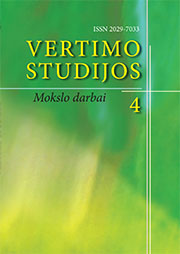GRAMMATICAL COMPRESSION IN FILM TRANSLATION
GRAMMATICAL COMPRESSION IN FILM TRANSLATION
Author(s): Greta Češumskaitė, Jurgita KerevičienėSubject(s): Theoretical Linguistics, Film / Cinema / Cinematography, Translation Studies
Published by: Vilniaus Universiteto Leidykla
Keywords: Translation strategy; Film translation;
Summary/Abstract: Nowadays translators employ various translation strategies in order to produce an adequate translation and further establish international communication. This paper deals with one translation strategy called compression which involves leaving out the target text elements present in the source text to retain the content of the words rather than preserve the structural adequacy of the text format. The degree of compression is constantly increasing in contemporary translations, due to an intensive lifestyle, the necessity to convey informational content as quickly as possible arises. Compression is widely employed in subtitling because of both the requirement to provide a very short target text by employing a restricted number of symbols allowed per one subtitle, and the necessity to express only the main idea of the utterances. Taking linguistic aspects into account, the translation strategy comprises of either grammatical or lexical ways to shorten the text without destroying its meaning. This paper presents the grammatical means of compression observed in film subtitling by shifting the primary focus on grammatical alternations found in different film genres.
Journal: Vertimo studijos
- Issue Year: 4/2011
- Issue No: 4
- Page Range: 71-81
- Page Count: 11
- Language: English

